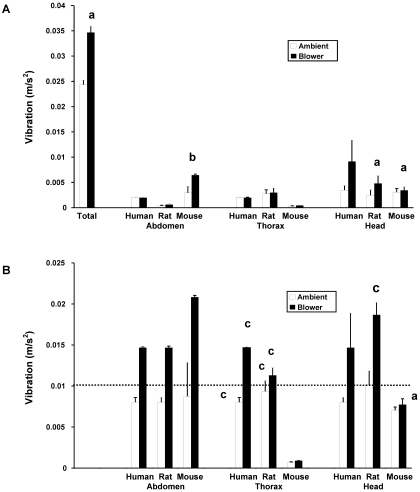Figure 2.
Total vibration and vibration levels in the (A) RFR and (B) SFR produced from ambient sources and the ventilated rack blower measured from inside the cage. (A) This panel represents the total vibration from ambient sources (n = 3) and that generated by the ventilated rack blower (n = 3) from 0 to approximately 12.5 kHz and the levels in the RFR. The total vibration was increased significantly (a, P ≤ 0.05) by the ventilated rack blower relative to ambient vibration. Mouse abdominal vibration from the ventilated rack blower was increased (b, P ≤ 0.01) relative to the abdominal RFR of blower-induced vibration of rats and humans. The vibration caused by the ventilated rack blower in the rat and mouse head RFR was increased (a, P ≤ 0.05) relative to ambient vibration in both of these respective ranges. (B) Both ambient and ventilated rack blower-induced thoracic vibration in the SFR was greater (c, P ≤ 0.05) for both humans and rats as compared with mice. Vibration generated by the blower in the head SFR was greater (c, P ≤ 0.05) for rats than mice; the blower-induced vibration in the mouse head SFR was significantly greater (a, P ≤ 0.05) than was ambient vibration in this frequency range. The dashed line represents the human perception threshold of 0.01 m/s2.

